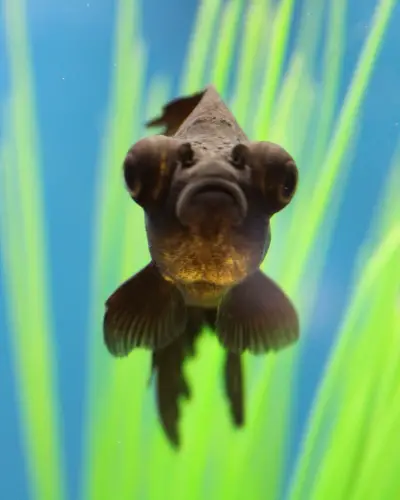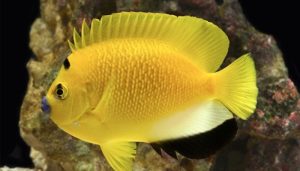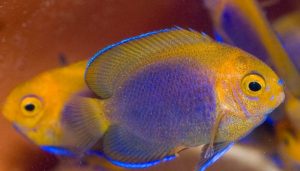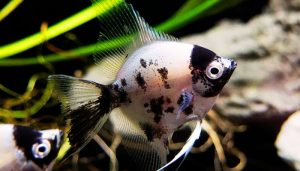Why Is Your Black Moor Gold Fish Turning Gold? The transformation of a black moor gold fish into a gold-colored variant can leave many aquarists puzzled. Understanding the reasons behind this change is essential for any fish keeper.
In this article, we will delve into the factors influencing the color change of black moor goldfish, what they should look like, their variants, and tips for caring for them in an aquarium.
By the end, you’ll have a comprehensive insight into maintaining the health and appearance of your beloved goldfish.
Table of Contents
ToggleDo Black Moor Fish Turn Gold?
Yes, black moor fish can indeed turn gold over time. This transformation is not uncommon among various goldfish varieties, including the black moor. As these fish age, their pigmentation may change due to genetics or environmental factors.
For instance, when raised in a tank with poor water quality or inadequate lighting, the black coloration may fade, allowing gold to emerge.
Additionally, temperature changes can also play a role in this transition, as warmer water may accelerate the fading process.

Therefore, it is crucial for aquarists to monitor water conditions to understand and manage this color change effectively.
Moreover, the change from a dark hue to a gold shade can sometimes be indicative of the fish’s health. In cases where the fish is stressed or unwell, the black moor gold fish may lose its vibrant black color.
Factors such as improper diet, parasites, or fungal infections could lead to this condition. Thus, it is essential for fish keepers to be vigilant and ensure that their aquarium environment promotes optimal health.
Regular water changes and maintaining good water parameters will help preserve the natural coloration of the black moor, allowing it to thrive in its aquatic home.
What Should a Black Moor Goldfish Look Like?
A healthy black moor goldfish should exhibit a deep black coloration with velvety skin and flowing fins. Its metallic scaled body shape is typically rounded, resembling a fancy goldfish, and it often features prominent, protruding eyes that add to its unique appearance.
The fins should be delicate and long, gracefully trailing behind as the fish swims. Any signs of discoloration, such as a loss of its black hue or the emergence of white patches, may indicate underlying health issues that need to be addressed promptly.
In addition, black moors generally have a robust body structure, making them a hardy choice for aquarists. They are often kept in community tanks alongside other goldfish varieties, such as the fantail or comet goldfish.
The compatibility of black moors with other species depends on the tank’s size and the behavior of the other fish.
Therefore, ensuring that the tank provides adequate space and privacy can help reduce stress and maintain the striking appearance of these goldfish. Regular observation of their behavior and condition is essential in ensuring that they remain vibrant and lively.
Other Variants OF Black Moor Telescope Goldfish
The black moor goldfish is just one of many variants in the goldfish family. Other popular types include the telescope eye goldfish, which is known for its distinctive bulging eyes, and the veiltail, which features long, flowing fins.
Additionally, the ryukin and oranda goldfish are also notable for their unique egg shaped bodies and fin structures.
Each variant has its own care requirements and aesthetic appeal, which makes them fascinating for aquarists. The diversity among goldfish varieties allows for stunning aquarium displays when different types are combined in a single tank.
Furthermore, these variants can sometimes interbreed, resulting in unique offspring that may exhibit characteristics from both parental lines.
For instance, a black moor might breed with a fantail goldfish, producing fish that may inherit the flowing fins of the fantail while maintaining the dark coloration of the black moor.
This selective breeding can lead to a variety of body shapes and colors, contributing to the allure of keeping goldfish. It is important for fish keepers to research the specific needs of each variant to ensure the best care and longevity of their aquatic pets.
3 Reasons Why Black Moor Gold Fish Turning Gold
Why did my black moor fish turn gold? There are several reasons why black moor fish turning gold, and understanding these factors is crucial for effective goldfish care.
- One primary reason is the natural aging process. As black moors mature, their pigmentation can change, often resulting in lighter colors.
- This color change can also be influenced by stressors such as poor water quality, inadequate diet, or lack of privacy within the tank. If the black moor feels threatened or uncomfortable, it may lose its vibrant black coloration, turning gold as a response.
- Additionally, environmental conditions play a significant role in this transformation. Water temperature, for instance, can influence the color of black moors. A sudden increase in temperature can lead to stress, prompting the fish to shed its black color.
Furthermore, the tank’s lighting can impact how colors appear; inadequate lighting can cause the black coloration to fade, revealing a more golden hue underneath.
Regular water changes, maintaining proper water parameters, and providing a well-decorated tank can help minimize stress and maintain the beautiful black coloration that these goldfish are known for.
How Big Do Black Moor Gold Fish Get?
Black moor goldfish can grow to be quite sizable, typically reaching up to 8 inches in length. However, their size can be influenced by the tank’s conditions, including water quality and space.
In a well-maintained aquarium with ample room, black moors can thrive and achieve their full potential size. It is essential for fish keepers to provide a tank that is at least 20 gallons to accommodate their growth properly.
Overcrowding can lead to stunted growth and health issues, so careful planning is necessary when adding new fish to a community tank.
Moreover, the lifespan of black moor goldfish can also be affected by their size. Generally, these fish can live for 10 to 15 years, given proper care. A larger tank allows for better water quality, which is crucial for their overall health.
The space also enables better flow and filtration, reducing the buildup of harmful substances like ammonia and nitrates.
By providing a spacious and clean environment, aquarists can support their black moor goldfish in reaching their maximum size and maintaining their vibrant appearance throughout their lifespan.
Caring for Black Moors in an Aquarium
Caring for black moor goldfish requires attention to various factors to ensure their health and well-being. A stable and clean aquarium environment is paramount, as these fish are sensitive to water quality.
Regular water changes, ideally around 25% weekly, can help maintain the optimal nitrate level and remove harmful substances.
Furthermore, it is essential to monitor the water temperature, keeping it within a range of 65 to 75 degrees Fahrenheit. Sudden fluctuations in temperature can stress the fish and lead to health issues.
Feeding is another critical aspect of black moor care. Providing a balanced diet that includes high-quality pellets, baby brine shrimp, live foods, frozen foods, and occasional vegetable matter foods can promote their health and vibrant coloration.
Overfeeding should be avoided, as it can lead to water quality issues and health problems, such as swim bladder disease.
Additionally, providing decorations and hiding spots within the tank can give black moors a sense of security, reducing stress and encouraging natural behaviors. All these components work together to create a thriving environment for black moor goldfish.
Aquarium Filters for Black Moors
Choosing the right aquarium filter is vital for maintaining a healthy environment for black moor goldfish. Since these fish produce a considerable amount of waste, a high-quality filter can help manage ammonia and nitrate levels effectively.
A canister filter or a hang-on-back filter with a sufficient flow rate is recommended to ensure proper water circulation and filtration. The filter should be capable of handling the tank’s size, ideally providing filtration for at least double the tank’s volume to keep the water clean and clear.
Additionally, regular maintenance of the filter is crucial. This includes cleaning or replacing filter media as needed to ensure optimal performance.
A well-maintained filter not only supports water quality but also enhances the overall aquarium environment, benefiting the black moor’s health. Incorporating a sponge filter can also assist in providing gentle water flow, which is suitable for these delicate fish.
Overall, investing in a reliable filtration system will contribute significantly to the longevity and vibrancy of your black moore gold fish.
Commonly Asked Questions about Black Moor Telescope Goldfish (FAQs)
Why is my Black Moor Goldfish turning gold?
Why is my black moor fish turning gold? Black Moor Goldfish can turn gold as they mature due to the natural process of color change in the carassius auratus species. This transformation can be influenced by factors such as genetics, age, and environmental conditions.
Does the water quality affect my Black Moor Goldfish’s color?
Yes, poor water quality can weaken the immune system of your Black Moor Goldfish. It is important to conduct partial water changes regularly to maintain a healthy environment, which can help preserve their color.
Can my Black Moor Goldfish get sick if the water is too warm?
Yes, if the heater is set too high for your tropical fish tank, it can stress your Black Goldfish, making them more susceptible to diseases like fluke, bacterial or fungal infections.
Should I provide direct sunlight for my Black Moor Goldfish?
No, exposing your Black Moor Goldfish to direct sunlight can lead to stress and potential health issues. Instead, provide a shaded area in their tank to ensure they feel secure.
What kind of food should I give my Black Moor Goldfish?
You should feed your Black Moor Gold fish high-quality pellets or flakes that are specifically formulated for goldfish. Make sure to provide enough food but avoid overfeeding, as it can lead to health issues.
Can a salt bath help my Black Moor Goldfish if they’re sick?
Yes, a salt bath can treat certain ailments and help your Black Moor Goldfish recover from diseases. However, make sure to follow proper guidelines for dilution and duration to avoid stressing the fish.
What is the difference between a Black Moor Goldfish and a normal-eyed goldfish?
Black Goldfish have distinctive bubble eyes, while normal-eyed goldfish have a more typical streamline appearance. These differences in eye structure can also affect their vision and swimming capabilities.
How can I prevent my Black Moor Goldfish from developing fungus?
Maintaining good water quality, avoiding overpopulation, and ensuring proper tank conditions can help prevent fungal infections in your Black Goldfish. Regular tank maintenance and monitoring are key.
What other types of goldfish can my Black Moor Goldfish live with?
Black moor telescope goldfish can coexist with other varieties like panda, calico, and lionheads as long as they are similar in size and temperament. Avoid aggressive species that may stress them out.
Where can I find more information about caring for my Black Moor Goldfish?
For more details on care, refer to our site map or contact us for additional resources. You can also review our privacy policy and disclaimer for guidelines on information usage.
Can gold fish mate with black moores?
Yes, goldfish and black moors can mate. They are the same species, just different varieties.
Will black moor goldfish eat plants?
Yes, some black moor goldfish may nibble on live plants, especially delicate ones. Choose sturdy, fast-growing plants like Java Fern or Anubias for their tank.
Conclusion
In conclusion, the transformation of black moor telescope goldfish into a gold coloration can stem from various factors, including genetics, environmental conditions, and health. As fish keepers, it’s important to understand and manage these elements to maintain the vibrant appearance of your pets. By providing a suitable aquarium environment, monitoring water quality, and offering a balanced diet, you can ensure the well-being of your black moors. Exploring the diverse variants of goldfish can also add excitement and beauty to your aquatic displays. Ultimately, with proper care and attention, your black moor goldfish can thrive and maintain its stunning looks for years to come.
You might also like
- Tank Requirements for Goldfish: (Care Basics & Expert Tips)
- Help! Black Spots on Goldfish: 3 Causes & Quick Solutions
- Breeding Lionhead Goldfish – The Ultimate Guide to Success!
- Bubble Eye Goldfish 101: Comprehensive Beginners Care Guide
- Goldfish with the Big Eyes: The Only Guide You’ll Ever Need
- 50+ Lovable Gold Fish Names: (Best Goldfish Names Ever)




